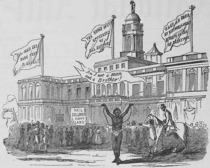VA.SS.VUS.1.a
Virginia History & Social Science Standards of Learning 2015
Grades 9-12
Learning Domain: VA/US History
Standard: The student will synthesize evidence from artifacts and primary and secondary sources to obtain information in order to increase understanding of events and life in Virginia and United States history.
Experiences may include, but are not limited to:
Examine and analyze information about the social/political organization, religion, and economics of a region. Use the information gathered to gain a new and deeper understanding of the inhabitants, resources, land and water usage, transportation methods, and communications of the region.
Examine and analyze geographic information and demographic data. Use the information gathered to gain a new and deeper understanding of conflicts within or among regions.
Prepare a collection of primary and secondary sources that best relate to a unit of study. Examine the sources to:
Make and record observations about the sources and generate questions about each item.
Determine commonalities, patterns in themes, relationships and connections the sources have to the overarching topic of the lesson.
Create a graphic organizer that describes how each source impacted the period of study.
Degree of Alignment:
Not Rated
(0 users)
VA.SS.VUS.1.c
Virginia History & Social Science Standards of Learning 2015
Grades 9-12
Learning Domain: VA/US History
Standard: The student will interpret charts, graphs, and pictures to determine characteristics of people, places, or events in Virginia and United States history.
Experiences may include, but are not limited to:
Gather information and create a chart of the characteristics of a revolution or movement to draw conclusions about its origins, principles, and the dissemination of its message.
Gather information from a variety of sources about people, places, and events in Virginia and United States history and organize the information into a chart or graph to draw conclusions.
Interpret a variety of visual sources to draw conclusions about people, places, and events in Virginia and United States history.
Degree of Alignment:
Not Rated
(0 users)
VA.SS.VUS.1.d
Virginia History & Social Science Standards of Learning 2015
Grades 9-12
Learning Domain: VA/US History
Standard: The student will construct arguments using evidence from multiple sources.
Experiences may include, but are not limited to:
To construct an argument, consider the following:
Apply a variety of planning strategies to generate, gather, and organize ideas to address a specific audience and purpose.
Produce arguments in writing, developing a thesis that demonstrates knowledgeable judgments, addresses counterclaims, and provides effective conclusions.
Organize ideas in a sustained and logical manner.
Clarify and defend the position with precise and relevant evidence, elaborating ideas clearly and accurately.
Adapt content, vocabulary, voice, and tone to audience, purpose, and situation.
Prepare evidence for a Socratic seminar in order to debate and discuss the costs and benefits of a government action or historical event.
Gather information from a variety of sources to assume a particular perspective from one time period, and write a newspaper editorial persuading readers to adopt the chosen perspective.
Degree of Alignment:
Not Rated
(0 users)
VA.SS.VUS.1.f
Virginia History & Social Science Standards of Learning 2015
Grades 9-12
Learning Domain: VA/US History
Standard: The student will explain how how indirect cause-and-effect relationships impacted people, places, and events in world history.
Experiences may include, but are not limited to:
A process for explaining indirect cause-and-effect relationships:
Choose an established effect and brainstorm causes of that effect.
Categorize and organize the causes into direct or indirect causes.
Describe direct and indirect items separately.
Compare and contrast direct and indirect causes.
Identify the most important difference between the direct and indirect causes.
Draw conclusions about the impact on people, places, and events
Discuss, defend, and refine conclusions.
Compare charts, graphs, and/or maps to determine the role diversity played in affecting the social, economic and political structure of the United States.
Create flow charts, story boards, and timelines to help students explore multiple causes and effects.
Determine how the choices of selected people/groups impacted American history.
Examine both intended and unintended consequences of an event:
What was the context for the event to take place?
What actions were taken?
What was the result of these actions?
Degree of Alignment:
Not Rated
(0 users)
VA.SS.VUS.2.a
Virginia History & Social Science Standards of Learning 2015
Grades 9-12
Learning Domain: VA/US History
Standard: The student will describe the characteristics of early exploration and evaluate the impact of European settlement in the Americas.
Essential Understanding:
Early European exploration, colonization, and the system of enslavement resulted in the redistribution of the world population as millions of people from Europe and Africa voluntarily and involuntarily came to the New World.
Degree of Alignment:
Not Rated
(0 users)
VA.SS.VUS.2.b
Virginia History & Social Science Standards of Learning 2015
Grades 9-12
Learning Domain: VA/US History
Standard: The student will describe cultural interactions among American Indians, Europeans, and Africans during the Age of Exploration.
Essential Understanding:
Exploration and colonization initiated worldwide commercial expansion and cultural interactions as products and people were exchanged between Africa, the Americas, and Europe.
Degree of Alignment:
Not Rated
(0 users)



Comments